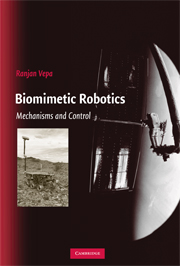Book contents
- Frontmatter
- Contents
- Preface
- Acronyms
- 1 The Robot
- 2 Biomimetic Mechanisms
- 3 Homogeneous Transformations and Screw Motions
- 4 Direct Kinematics of Serial Robot Manipulators
- 5 Manipulators with Multiple Postures and Compositions
- 6 Grasping: Mechanics and Constraints
- 7 Jacobians
- 8 Newtonian, Eulerian, and Lagrangian Dynamics
- 9 Path Planning, Obstacle Avoidance, and Navigation
- 10 Hamiltonian Systems and Feedback Linearization
- 11 Robot Control
- 12 Biomimetic Motive Propulsion
- Answers to Selected Exercises
- Appendix: Attitude and Quaternions
- Bibliography
- Index
10 - Hamiltonian Systems and Feedback Linearization
Published online by Cambridge University Press: 20 February 2010
- Frontmatter
- Contents
- Preface
- Acronyms
- 1 The Robot
- 2 Biomimetic Mechanisms
- 3 Homogeneous Transformations and Screw Motions
- 4 Direct Kinematics of Serial Robot Manipulators
- 5 Manipulators with Multiple Postures and Compositions
- 6 Grasping: Mechanics and Constraints
- 7 Jacobians
- 8 Newtonian, Eulerian, and Lagrangian Dynamics
- 9 Path Planning, Obstacle Avoidance, and Navigation
- 10 Hamiltonian Systems and Feedback Linearization
- 11 Robot Control
- 12 Biomimetic Motive Propulsion
- Answers to Selected Exercises
- Appendix: Attitude and Quaternions
- Bibliography
- Index
Summary
Dynamical Systems of the Liouville Type
William Rowan Hamilton was a remarkable dynamicist who was considered to be the greatest mathematician, after Sir Isaac Newton, of the English-speaking world. Born in Dublin in 1805 and named after an outlawed Irish patriot, Archibald Hamilton Rowan, William R. Hamilton died in 1865 as the Astronomer Royal of Ireland. In the span of 60 years he was responsible for a remarkable number of new concepts, including the calculus of the quaternion, a generalization of a complex number to three-dimensional space. Hamilton's discovery not only led to Arthur Cayley's application, in 1854, of the quaternion to the representation of spatial rotations but also led to the development of new algebras, including the theory of matrices and the algebra associated with biquaternions, defined in 1873 by William Kingdon Clifford. In 1834, when he was just 29 years of age, Hamilton wrote to his uncle: “It is my hope and purpose to remodel the whole of dynamics, in the most extensive sense of the word, by the idea of my characteristic function.” He proceeded to apply this principle to the motion of systems of bodies, and in the following year expressed these equations of motion in a form that established a duality between the components of momentum of a system of bodies and the coordinates of their positions. He largely achieved his objectives and, in the process, set out on a quest for simplicity that yielded remarkable dividends.
Before Hamilton's general equations of motion are introduced, it is instructive to consider a restricted class of dynamical systems associated with name of Liouville.
- Type
- Chapter
- Information
- Biomimetic RoboticsMechanisms and Control, pp. 198 - 241Publisher: Cambridge University PressPrint publication year: 2009
- 1
- Cited by

